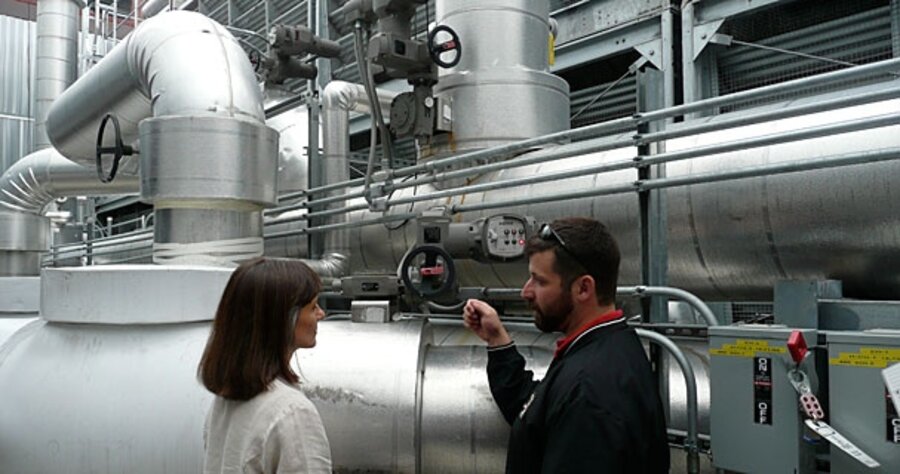Campuses find going green can be tough
Loading...
| Burlington, Vt.
Set up recycling bins? Check. Change the light bulbs? Check.
Go carbon neutral? That one’s not so easy. But with 587 presidents having pledged their colleges and universities to reduce their greenhouse-gas impact to zero, lessons are beginning to emerge about what it will really take to get there – on campus and beyond.
Campuses account for a small portion of the United States’ greenhouse-gas emissions – less than 5 percent by some estimates. But many see themselves as well positioned to promote environmental sustainability – as centers of innovation, models of social responsibility, and educators of future workers and decisionmakers.
“Climate planning is an emerging field, and … the plans [colleges] come up with will be helpful to folks in other sectors learning to do this for the first time,” says Julian Dautremont-Smith, associate director of the Association for the Advancement of Sustainability in Higher Education (AASHE). Based in Lexington, Ky., it’s one of the groups overseeing the American College & University Presidents Climate Commitment, which requires signers to report publicly on their progress.
Before a campus can map its way to zero, it has to understand the details of its carbon footprint, a sometimes tedious data-crunching task that’s proving more challenging than many anticipated. Greenhouse-gas inventories from the original 391 signers were due Sept. 15. So far, 190 have been submitted; another 98 schools had asked for extensions, some because of budget and hiring freezes and others because they didn’t plan well enough to complete the inventories on time, Mr. Dautremont-Smith says.
But he adds that he’s not discouraged by the missed deadlines, given the sweeping, multi-decade nature of the commitment.
Schools that got off to an early start, on the other hand, can now document the payoff of their early emissions-trimming steps, and share what they’re learning as they try to plan more difficult changes.
The University of Vermont’s Greenhouse Gas Inventory, for example, goes back far enough to show that emissions levels are now nearly as low as in 1990, despite campus growth. It boils down years of data on cars, cows, and all things energy consuming into a few pages, and is the starting point for coming up with a “climate action plan” by next fall to go carbon neutral.
With heating during Vermont’s long winters accounting for 70 percent of the campus’s emissions, the school has been replacing old, leaky underground steam pipes to improve efficiency. “You used to be able to see where the steam pipe went because it would melt [the snow] in winter … and there were robins eating worms in some places,” says UVM sustainability director Gioia Thompson with a laugh.
Upgrading the infrastructure has been messy and has cost nearly $14 million since 2003. But because of that investment, the campus has been able to add nearly 500,000 square feet of new facilities and at the same time reduce its steam output, which reduces emissions.
Centralized control of building temperatures has also made a difference. Faculty and grad students used to be able to control the thermostat when they wanted to work in the middle of the night. Now, Ms. Thompson says, “there’s more of that concept of scheduling building use, and beginning to tell people what they can and cannot do, which has been a big culture change for faculty.”
Slowly but surely, faculty and students are also being weaned off cars. Their local commuting makes up 12 percent of campus greenhouse gases. Biking incentives, shuttle buses (powered by biofuel and compressed natural gas), and more-flexible parking permits have all helped. But as fewer people need to pay parking fees and fines, “that drives a loss of revenue,” says Katherine Decarreau, director of transportation and parking services. Finding a sustainable funding stream for her green initiatives is the next challenge, she says.
These are some examples of how “the low-hanging fruit has been picked,” Thompson says. While proud of UVM’s accomplishments so far – including a new student center that meets the highest green-building standards – she wants to see emissions go down, not just hold steady.
For UVM and other campuses, it’s key that decisionmakers break out of traditional “silos” to come up with climate action strategies, says Sally DeLeon, a research fellow at the Rocky Mountain Institute, a nonprofit energy policy think tank in Snowmass, Colo.
“A lot of times, the barrier is stated as, ‘It’s too expensive,’ ” when it comes to investing in a new heating or cooling system, she says, but often the real problem is that capital and operating budgets are looked at separately, which makes it difficult to account for money that would be saved down the road.
Factors beyond campus boundaries also play a major role. Some of UVM’s progress is due to the local Burlington Electric’s commitment to renewable sources such as hydroelectric power and a wood-burning generating station. UVM’s electricity emits about 13 percent of the campus’s greenhouse gases, but it’s much cleaner than that available on most campuses.
Universities can’t go carbon neutral on their own, Thompson says. “What we need to figure out next is how can we work with our community…. Significant reductions will require changes beyond the campus – locally, regionally, and nationally…. It’s going to be a really wild ride.”





